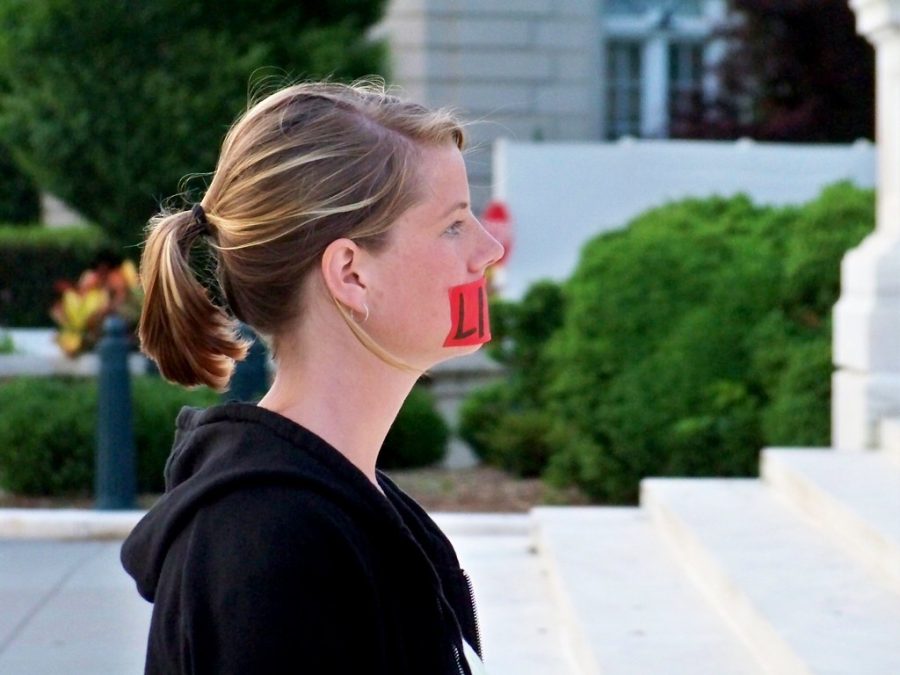Opinion: As the Ideological Chasm Widens
The Supreme Court appears poised to overturn Roe v. Wade, raising questions of what our country means and does not mean by the term “pro-life.”
SchuminWeb is licensed under CC BY-SA 2.0.
A pro-life demonstrator in front of the U.S. Supreme Court in Washington.
May 20, 2022
When sitting down to write this article, I was immediately struck by a strong wave of deja vu—owing to a previous article I authored in September about Texas’s controversial “Heartbeat Bill,” S.B. 8, which effectively imposed a ban on all abortions after six weeks of pregnancy. Yet from the commencement of the school year to its end, little has changed.
Earlier this month on May 2, 2022, Politico obtained and published a leaked draft of a Supreme Court majority opinion written by Justice Samuel Alito that overturned the longstanding legal precedent on abortion, Roe v. Wade. It is important to keep in mind that this ruling is not set in stone and is not necessarily reflective of where the final opinion will land, but it’s pretty clear what the likely outcome will be.
For those who knew about S.B. 8, this is beyond surprise or mourning. The previewed decision was only a grim confirmation of what I already expected of the Court, who made their allegiance to partisanship instead of legal principle clear when they ruled against the preliminary injunction.
I’ll even offer the same disclaimer for this article. Abortion is without a doubt, at the forefront of the political warfare that plagues modern America. According to one Gallup poll, 47% of Americans say abortion is an important issue to their vote, and 24% say their chosen candidate must share their abortion views. Culture, family, religion—these are the hills voters are willing to die on, and all of those issues underlie abortion.
Yet, for such a polarizing topic, the room for consensus is extensive—and yet remains largely uncharted. Regardless of where on the spectrum one’s views on abortion may lie, nearly all agree that the best scenario is one in which abortion is not needed. The divergence is due to what means both sides believe is the best course of action to achieve this.
For pro-lifers, making abortion illegal has always been the primary item on the marching list. Intuitively, this should come close to achieving their goal—a world where no abortions are performed.
However, the evidence for criminalization actually significantly reducing abortions is mixed at best; an article published in the Federalist states that data from Poland, South Korea, and Austria comparing periods of legalized and illegalized abortion shows a reduction in abortion rates of about 5-10%. However, the author acknowledges that the data from Poland and South Korea is inconsistent and does not take miscarriages into account. They claim the Austria data corrects for this, but the data does not show that abortions decreased after illegalization, but rather that they increase after legalization. The issue is that the data displays reported conceptions that ended in abortion, but clearly illegal “back alley” abortions are less likely to be reported.
One study from Singh et. al finds in an analysis of global abortion rates that “Abortions occur as frequently in the two most-restrictive categories of countries (banned outright or allowed only to save the woman’s life) as in the least-restrictive category (allowed without restriction as to reason)—37 and 34 per 1,000 women, respectively.” This difference is not statistically significant.
Criminalization will likely result in a reduction in abortions, but it will never even approach fully eliminating them.
History also presents a grim reminder of a society devoid of access to safe and legal abortions. Under the reign of dictator Nicolae Ceaușescu in 1966-1990 Romania, society resembled a dystopian world not far from Margaret Atwood’s popularly alluded to the novel, The Handmaid’s Tale, with policy that “essentially nationaliz[ed] Romanian women’s wombs”—making both abortion and contraception illegal. By the end of Ceaușescu’s regime, nearly 7.3 million back-alley abortions were performed, killing at least 15,000 women as a result of complications and untreated side effects. Furthermore, during this period Romania’s infant-mortality rate was the highest in Europe.
There is inconsistency between the purported benefits of anti-abortion legislation and its realities. This is even starker given that the same people who champion “pro-life” causes often simultaneously oppose policies that have been shown to reduce abortion rates.
For one, abstinence-only sex education has long been governmentally funded and backed by conservative figures, despite the fact that studies show it is not an effective way of reducing teen pregnancies. The five states that do not require sex education and if/when it is taught require abstinence to be emphasized, i.e. Arkansas, Mississippi, Louisiana, Texas, and Arizona, are the same ones dotted throughout the highest teen pregnancy rates (#1, #2, #3, #9, and #20 respectively.)
Furthermore, increased access to contraception is a major contributor to lowering unintended pregnancies. A study found that providing birth control to women at no cost substantially reduces unplanned pregnancies and cuts abortion rates by 62-78% compared to the national rate.
Another factor that contributes is the abysmal state of childcare in the United States and the absence of federally mandated paid parental leave—something that no other developed country lacks. Yet, this vital legislation was dropped from President Biden’s “Build Back Better” plan, due to near unanimous Republican and some Democrat opposition in Congress.
Comprehensive sex education, more accessible contraceptives, paid leave, universal childcare, reform of the foster care system, etc… It is evident that other means to reduce abortion rates can be just as, if not more effective than criminalization—and they aren’t associated with the bloody cost of unsafe abortions. Lawmakers need to recognize that policy is not enacted in a vacuum—without addressing these core necessities, outlawing abortion does not eliminate them, but instead outsources them to more dangerous means.
To be clear, that does not mean that every person who identifies as Republican opposes these proposals. Ironically, many of these policies aren’t even unpopular among the general population, Democrat or Republican. But when it comes to getting the votes to systemically effect these changes, representatives seem to automatically fall back into party lines.
Presenting criminalization as the linchpin in reducing abortions but being unwilling to do any of the work associated with supporting those most susceptible to unplanned pregnancy or addressing the root causes of abortion is punitive, not protective.
As Finer et al. puts it, “…”unintended pregnancy” does not fully capture the reasons and life circumstances that lie behind a woman’s decision to obtain an abortion. What personal, familial, social, and economic factors lead to the decision to end a pregnancy?” They find that the primary motivations behind abortions are resource limitations, like financial instability, interference with education, and lack of partner support. Rates of unintended pregnancy are much higher for women of lower socioeconomic status, who are less educated, and who are minorities.
The ideological inconsistency telegraphs two possibilities: either pro-life politicians are displaying willful ignorance towards the statistical reality of criminalization, or their motivations are simply not what their positions claim.
There is a massive amount of cognitive dissonance when it comes to the dichotomy between pro-life ideals and pro-life actions. And even for politicians, some of the hypocrisy is almost too blatant to believe.
Pennsylvania voters still remember former Representative Tim Murphy’s fall from grace and subsequent resignation after reports surfaced that he, a pro-life politician that had previously supported legislation severely restricting abortions, had asked his mistress to abort their unborn child.
Politicians can afford to exercise this paradoxical philosophy because the reality is the rich and powerful will always have access to abortions; they will have the means to travel to wherever it is legal, to access the best health specialists, and even to circumvent legal measures if need be. Criminalization is an axe that will fall the hardest on poor, working-class, women of color.
Even irrespective of whether one agrees with the moral designations pro-life stances place on abortions, the frustration stems more from the fact that in terms of policy, advocates seem to pick and choose which “lives” to unconditionally defend—if protecting unborn lives really is the end goal, why oppose social programs that demonstratively mitigate instances where abortion is needed?
Perhaps the “pro-life” stance is simply a farce—a smokescreen to draw passionate voters in without any of the political labor associated with pursuing consequential ends.
Methodist pastor Dave Barnhart put it best in a 2018 Facebook post:
“The unborn” are a convenient group of people to advocate for. They never make demands of you; they are morally uncomplicated, unlike the incarcerated, addicted, or the chronically poor; they don’t resent your condescension or complain that you are not politically correct; unlike widows, they don’t ask you to question patriarchy; unlike orphans, they don’t need money, education, or childcare; unlike aliens, they don’t bring all that racial, cultural, and religious baggage that you dislike; they allow you to feel good about yourself without any work at creating or maintaining relationships; and when they are born, you can forget about them, because they cease to be unborn. You can love the unborn and advocate for them without substantially challenging your own wealth, power, or privilege, without re-imagining social structures, apologizing, or making reparations to anyone…”
Identifying as pro-choice can stem from a host of reasons—women’s social and cultural equality, belief in individual autonomy, a rejection of the government’s regulation of deeply personal decisions. But what is often overlooked is the fact that being personally opposed to abortion and being pro-choice are not mutually exclusive, and the fundamental discrepancies that run in an undercurrent of Republican stances seemingly contradict even pro-life viewpoints.
In our current political climate, ideology is like a fire; left untamed, it does not seek compromise or reconciliation, only further division and destruction. It blinds us to humanity, neutralizes empathy, and reduces citizens to their political views. As the ideological chasm that splits America into two halves widens each day and the middle ground in between crumbles, it is ever vital to recognize when words don’t match actions, to question and cut through the tangle of peripheral persuasion and rhetoric to reveal whether any substance lies beneath the surface.
_____________________________________________________________________________________
Editors’ note: All opinions expressed on The Uproar are a reflection solely of the beliefs of the bylined author and not the journalism program at NASH. We continue to welcome school-appropriate comments and guest articles













